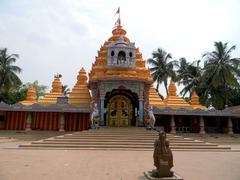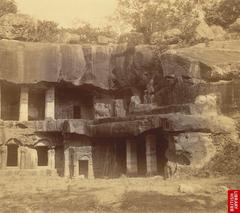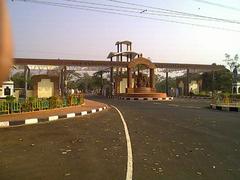Jaleswar Siva Temple Precinct, Bhubaneswar: Visiting Hours, Tickets, Architecture & Complete Visitor Guide
Date: 04/07/2025
Introduction
The Jaleswar Siva Temple Precinct stands as one of Bhubaneswar’s remarkable heritage sites, offering a rare blend of spiritual vibrancy, architectural distinction, and living tradition. Situated near Kalarahanga village on the city’s southern edge, this 12th-century temple exemplifies the Kalinga architectural style and maintains an enduring association with water, earning its name “Jaleswar” or “Lord of the Waters.” Adjacent to the tranquil Jalesvara pond, the precinct is a hub of Shaivite and Shakta worship, with festivities like Maha Shivaratri and Durga Ashtami drawing crowds of devotees and cultural enthusiasts each year.
This guide provides in-depth information on the temple’s history, artistic significance, visiting hours, ticketing, accessibility, and nearby attractions—ensuring you have all you need for a meaningful visit to one of Bhubaneswar’s most cherished temples. For further details, refer to Temples of India and Bhubaneswar Tourism.
Table of Contents
- Overview & Historical Background
- Legends and Mythology
- Architectural Highlights
- Visiting Information (Hours, Tickets, Accessibility, Directions)
- Festivals, Rituals & Living Traditions
- Artistic and Iconographic Features
- Nearby Attractions & Travel Tips
- Frequently Asked Questions (FAQ)
- Resources & References
Overview & Historical Background
The Jaleswar Siva Temple Precinct is located about 2 km from Patia and 6 km south of Chudangagada, set within a compound wall and bordered by the Jalesvara pond. The temple’s origins trace to the Keshari (Somavamsi) dynasty in the 12th century CE, with local tradition crediting Padma Keshari as its patron—though this is not confirmed by inscriptional evidence. Its architectural elements unmistakably align with the Somavamsi-Keshari temple-building tradition that flourished in Bhubaneswar during the medieval era (Wikipedia; Apni Sanskriti).
Legends and Mythology
The temple’s name and location reflect a deep association with water, derived from legends of the King of Chudangagada. During the rainy season, when visiting the Lingaraja Temple was difficult, the king is said to have received a divine vision instructing him to establish a temple in a pond’s center, symbolizing the deity as Jalasayi, “the one who lies in water.” Following this vision, the Jaleswar Siva Temple was constructed on the west embankment of the Jalesvara pond. Land grants to Brahmins and temple servants led to the development of the Kalarahanga area (Temples of India; MyAdhyatm).
Architectural Highlights
A classic of Kalinga architecture, the temple comprises:
- Vimana (Sanctum Tower): 11.36 meters high, richly adorned with sculptural motifs—pidha mundi, khakhara mundi, vajra mundi, rekha mundi.
- Jagamohana (Assembly Hall): A spacious hall for congregational worship.
- Antarala (Vestibule) & Nata-mandira (Dancing Hall): Transitional and ceremonial spaces.
- Sanctum: Houses the Siva lingam set within a circular yonipitha, symbolizing the union of Shiva and Shakti.
Decorative carvings feature saptamatrikas, dikpalas, mythological narratives, lotus medallions, and other sacred motifs. The complex also includes subsidiary shrines and the sacred Jalesvara pond, integral to ritual bathing and ablutions (Apni Sanskriti; TravelsnWrite).
Visiting Information
Visiting Hours
- Open Daily: 6:00 AM – 8:00 PM
- Best to visit early mornings or evenings for rituals and a tranquil atmosphere.
Tickets & Entry
- Entry Fee: Free; donations encouraged for temple upkeep.
- Guided Tours: Local guides and tour operators offer in-depth tours. Book in advance, especially during festivals (Bhubaneswar Tourism).
Accessibility & Facilities
- Location: Kalarahanga, approximately 10 km from Bhubaneswar city center.
- Transport: Accessible via taxi, auto-rickshaw, or local buses. Nearest railway station: Bhubaneswar; nearest airport: Biju Patnaik International (15 km).
- Facilities: Drinking water, restrooms, and shoe storage available at the entrance. The precinct has paved pathways but may have some uneven surfaces; assistance can be requested from staff.
Dress Code & Conduct
- Modest attire required; shoulders and knees covered.
- Footwear must be removed before entering the temple.
- Photography permitted in outer precincts, but restricted inside the sanctum; always ask permission.
Best Time to Visit
- October–March offers pleasant weather.
- Festivals like Maha Shivaratri and Siva Vivaha provide a vibrant experience but attract larger crowds.
Festivals, Rituals & Living Traditions
The Jaleswar Siva Temple is a living temple, hosting daily rituals and special pujas. Major festivals include:
- Maha Shivaratri: Night-long prayers, abhisheka, and cultural performances.
- Durga Ashtami (Durga Puja): Especially significant for the Kalabhairavi (Chamunda) shrine.
- Kartik Purnima, Shravan Mondays: Seasonal rituals, floral offerings, devotional music.
- Life-Cycle Ceremonies: Thread ceremonies, mundanakriya (first haircut), engagements, and birthdays—reflecting the temple’s role in community life.
The precinct’s syncretic worship of both Shaivite and Shakta deities is exemplified by the Kalabhairavi Temple, home to Chamunda with four arms, seated over a corpse, and adorned with a skull garland (Wikipedia).
Artistic and Iconographic Features
The temple’s sculptural artistry includes:
- Pidha mundi, khakhara mundi, vajra mundi motifs on the vimana’s base.
- Lintels with navagrahas (nine planetary deities).
- Images of saptamatrikas, dikpalas, Saivite deities, alasa kanyas (graceful maidens), and mythical creatures.
- Door jambs intricately carved with river goddesses, auspicious symbols, and protective figures.
- Central Siva-lingam on circular yonipitha, symbolizing the cosmic balance of Shiva and Shakti (MyAdhyatm; Trek.Zone).
Nearby Attractions & Travel Tips
Enhance your Bhubaneswar visit with these nearby sites:
- Lingaraj Temple: Iconic 11th-century Shiva temple, central to Bhubaneswar’s identity.
- Mukteshwar Temple: Renowned for its ornate torana and exquisite carvings.
- Rajarani Temple: Famous for reddish-gold sandstone and annual music festival.
- Udayagiri & Khandagiri Caves: Ancient Jain and Hindu rock-cut caves with inscriptions.
- Dhauli Shanti Stupa: Peace pagoda marking the Kalinga War’s end.
- Bindu Sarovara: Sacred lake near Lingaraj Temple.
- Odisha State Museum & Nandankanan Zoo: For culture and nature enthusiasts.
Travel Advice:
Public transport, taxis, and app-based cabs are widely available. Accommodation ranges from budget hotels to luxury stays. Sample local Odia cuisine and shop for traditional handicrafts in Old Town (OdishaTour.in; Stamped Moments).
Frequently Asked Questions (FAQ)
Q: What are the Jaleswar Siva Temple visiting hours?
A: Daily, 6:00 AM – 8:00 PM.
Q: Is there an entry fee or ticket required?
A: No ticket required; donations appreciated.
Q: Are guided tours available?
A: Yes, via local guides or authorized tour operators.
Q: How accessible is the temple?
A: The precinct is generally accessible, though some surfaces may be uneven; inquire locally for assistance.
Q: Can non-Hindus enter?
A: Non-Hindus are welcome in the outer precinct but may have restricted access to the sanctum.
Q: Is photography allowed?
A: In outer precincts, yes; inside sanctum, seek permission.
Visuals and Media
View Jaleswar Siva Temple on Google Maps
Summary and Visitor Tips
The Jaleswar Siva Temple Precinct is a living testament to Odisha’s spiritual and artistic heritage. Its harmonious setting, water symbolism, and intricate Kalinga architecture make it both a devotional and cultural highlight. Proximity to other historical sites and absence of entry fees make it welcoming for all. For a richer experience, consider guided tours and time your visit during festivals.
For ongoing updates, travel tips, and personalized guides, download the Audiala app and follow official tourism channels.
References and Further Reading
- Jaleswar Siva Temple Precinct, Wikipedia, 2025
- Temples of India, Jaleswar Siva Temple Bhubaneswar, 2025
- Apni Sanskriti, Jaleswar Siva Temple Kalarahanga Bhubaneswar, 2025
- Pilgrimaide, Jaleswara Siva Temple Bhubaneshwar, 2025
- MyAdhyatm, Baba Jaleswar Temple, 2025
- Trek.Zone, Jaleswar Siva Temple Precinct Bhubaneswar, 2025
- OdishaTour.in, Bhubaneswar Famous Temples Tourist Places, 2025
- Stamped Moments, Bhubaneswar Travel Guide to the Temple City, 2025
- TravelsnWrite, 10 Must See Temples of Bhubaneswar, 2025
- Bhubaneswar Official Tourism Website, 2025








